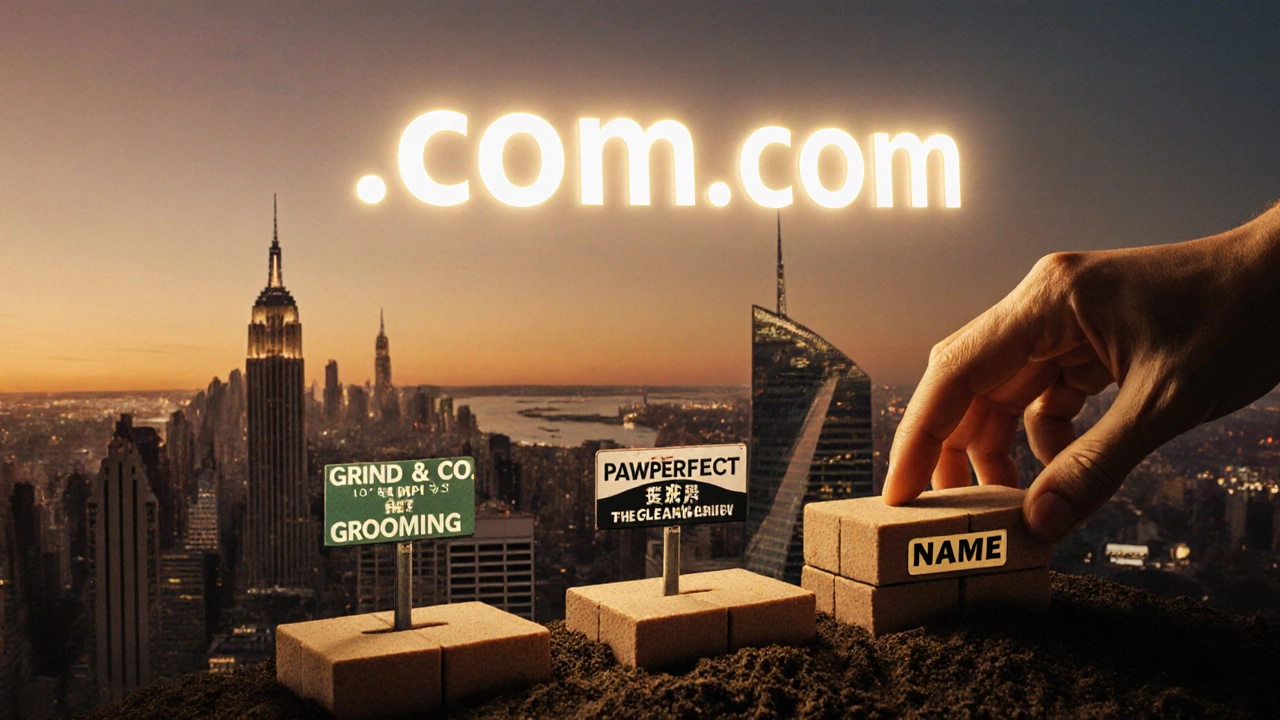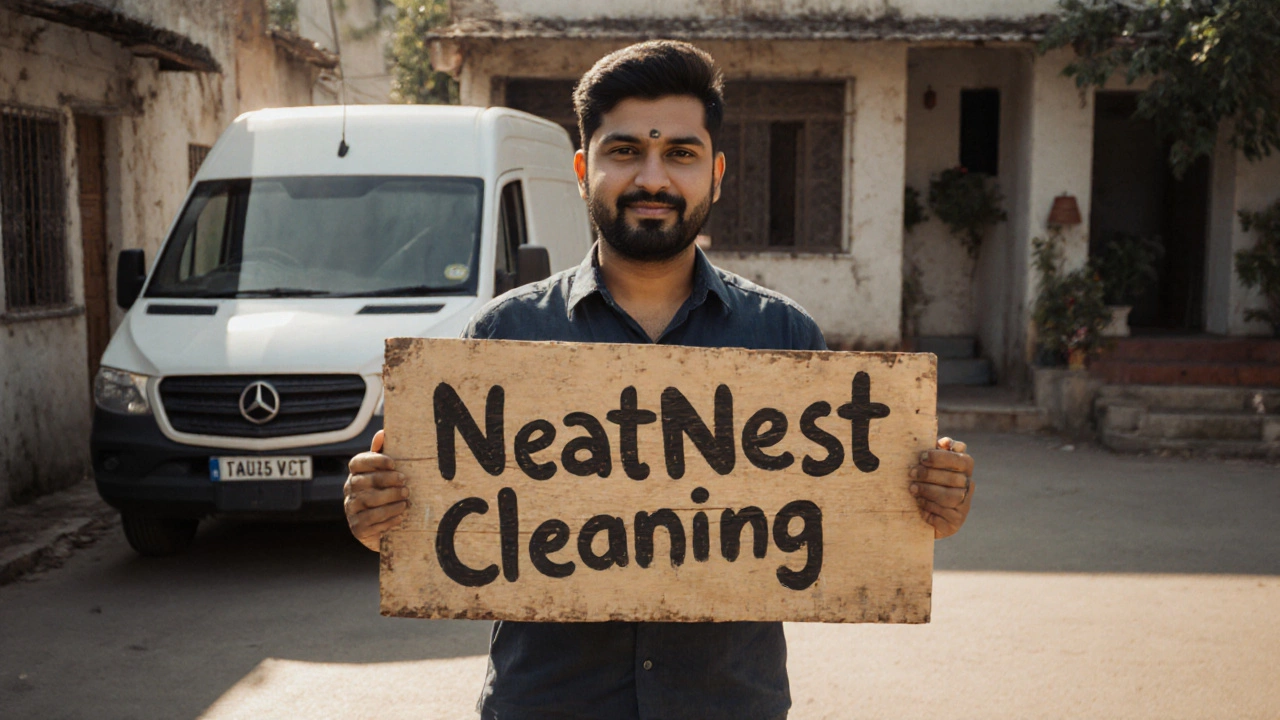Choosing a name for your small business isn’t just about picking something that sounds nice. It’s the first impression customers will have, the foundation of your brand, and the thing people will search for online. A bad name can make you invisible. A good one can pull customers in before you even open your doors.
Why Your Business Name Matters More Than You Think
Think about the last time you searched for a local service-maybe a plumber, a bakery, or a dog groomer. You didn’t type in ‘best service near me.’ You typed in the name. If your business doesn’t show up when someone searches for what you do, you’re losing sales before you start.
Google’s algorithm doesn’t just look at keywords. It looks at brand signals. A clear, memorable name with a matching domain and social handles tells Google you’re legitimate. It also makes it easier for people to talk about you. If your name is QuickFix Plumbing, someone’s more likely to say, ‘Call QuickFix,’ than if your name is Evergreen Solutions & Associates LLC.
Studies show businesses with simple, descriptive names get 30% more direct traffic from local searches. That’s not magic. That’s how people think.
What Makes a Good Small Business Name?
Not all names are created equal. Here’s what actually works in 2025:
- Easy to say and spell - If someone has to sound it out twice, they won’t remember it. Avoid ‘XyloTech’ or ‘QwikKlean.’
- Short and punchy - Three to five syllables max. ‘BrewHaus’ works. ‘The Artisan Coffee Roasting Company’ doesn’t.
- Tells people what you do - ‘Pawfect Pet Grooming’ immediately tells you it’s for pets. ‘Luxe Interiors’? Maybe. But ‘Luxe’ alone? No clue.
- Works online - Check if the .com domain is free. Check Instagram, Facebook, and TikTok handles. If they’re taken, move on.
- Scalable - Don’t lock yourself into a location or service you might outgrow. ‘Austin Lawn Care’ is fine today, but what if you expand to landscaping or tree removal?
Names like ‘Domino’s Pizza’ or ‘Walmart’ aren’t descriptive, but they became iconic because they were simple, repeatable, and had strong branding behind them. Most small businesses don’t have that kind of budget. So stick with clarity over cleverness.
10 Proven Naming Strategies That Work
Here are real-world patterns that successful small businesses use-no fluff, no buzzwords.
- Use your name + what you do - ‘Maria’s Hair Studio,’ ‘Raj’s Auto Repair.’ Simple, personal, trustworthy. People like doing business with people, not corporations.
- Combine two words - ‘BakeMyDay,’ ‘PetPals,’ ‘CleanSwift.’ Mash up a verb or adjective with a noun. Easy to remember, often available as a domain.
- Use a location - ‘Downtown Book Nook,’ ‘Northside Tacos.’ Great for local service businesses. Helps with Google Maps rankings.
- Be descriptive - ‘FastFix Laptop Repair,’ ‘24/7 Locksmith.’ Tells customers exactly what you offer. No guessing.
- Use a play on words - ‘The Scone’s The Word’ (bakery), ‘Paw-some’ (pet store). Fun, but only if it’s obvious. Don’t force it.
- Go abstract but catchy - ‘Nest,’ ‘Slack,’ ‘Zoom.’ Works if you’re building a brand, not just a service. Risky for new businesses without marketing budgets.
- Use a word from another language - ‘Saudade’ (Portuguese for deep longing) for a cozy café. Sounds unique, but only if it fits your vibe and isn’t hard to pronounce.
- Start with ‘The’ - ‘The Clean Crew,’ ‘The Artisan Butcher.’ Adds authority. Works well for premium or niche services.
- Use a verb - ‘GrowWell,’ ‘FixItFast,’ ‘MoveEasy.’ Action-oriented names suggest results.
- Test it with real people - Don’t just ask your friends. Ask strangers. Say the name out loud. Can they spell it after hearing it once? Can they find it on Google?
What to Avoid Like the Plague
Here are the biggest naming mistakes small business owners make-and why they cost money.
- Overcomplicating - ‘SynergiCore Digital Solutions Group’? No. Just no. You’re not a Fortune 500 company.
- Using numbers or symbols - ‘Tech4U’ or ‘Bakery@2025’ looks unprofessional. And it breaks SEO.
- Being too generic - ‘Best Services,’ ‘Top Quality,’ ‘Reliable Plumbing.’ These names don’t stand out. They blend into the noise.
- Choosing a name that’s already taken - You don’t want to get a cease-and-desist letter after spending $5,000 on branding. Check trademarks at USPTO.gov (or your country’s equivalent).
- Ignoring how it sounds - ‘FartBuster Cleaning’ might get laughs, but not paying customers. Say it out loud. Does it sound like something you’d recommend to your mom?
Checklist: Before You Finalize Your Name
Run this checklist before you commit. It takes 10 minutes, but it could save you thousands.
- Is the .com domain available? (Use Namecheap or GoDaddy to check)
- Are social media handles free on Instagram, Facebook, and TikTok?
- Can you say it clearly over the phone?
- Does it sound like a competitor’s name?
- Is it easy to spell without seeing it written?
- Does it mean something weird in another language? (Use Google Translate to check Spanish, Hindi, Mandarin)
- Is it already trademarked? (Search your country’s trademark database)
- Would you feel proud to put it on a sign, a business card, or a T-shirt?
Real Examples from Real Small Businesses (2025)
Here are names that work-because they followed the rules above.
- Grind & Co. - A coffee shop in Pune. Short, stylish, hints at coffee culture.
- NeatNest Cleaning - A home cleaning service in Bangalore. Clear, trustworthy, easy to remember.
- FixMyPhone Jaipur - A phone repair shop. Location + service = instant clarity.
- YogaWithRiya - A personal yoga instructor. Personal branding works wonders.
- BiteBuddy - A meal prep service for busy parents. Fun, descriptive, brandable.
Notice a pattern? None of these are trying to be ‘innovative.’ They’re trying to be found.

What If You Still Can’t Decide?
Here’s a trick: Write down 10 names. Then cross out the ones that don’t pass the phone test. Ask five people: ‘What do you think this business does?’ If three of them guess wrong, scrap it.
Or better yet-use a free tool like NameSnack or BusinessNameGenerator.com. They generate names based on keywords you enter. Use them as inspiration, not gospel.
And if you’re still stuck? Pick one. Launch. Get customers. Then tweak the name later if you need to. Most businesses evolve. Your name doesn’t have to be perfect on day one-it just has to be good enough to start.
Final Thought: Your Name Is a Promise
When someone hears your business name, they form an expectation. ‘QuickFix’ promises speed. ‘The Book Nook’ promises cozy. ‘BiteBuddy’ promises convenience.
Make sure your name matches what you actually deliver. A name that overpromises will backfire. A name that underpromises will get ignored.
Don’t overthink it. Don’t chase trends. Don’t copy your competitor. Pick a name that’s clear, simple, and true to what you do. Then go build something great.
Can I change my business name later?
Yes, but it’s expensive and messy. You’ll need to update your legal documents, bank accounts, website, social media, signage, marketing materials, and Google Business Profile. It can cost $1,000-$5,000 and take weeks. Pick a name you can live with for at least 3-5 years.
Should I use my own name for my business?
If you’re a service-based business-like a consultant, photographer, or personal trainer-using your name builds trust and personal connection. But if you plan to sell the business later, a name tied to you makes it harder to transfer. Think long-term.
Is it okay to use a made-up word?
Only if you have the budget to build awareness. Companies like Google, Spotify, and TikTok spent millions making their names famous. For a small business, it’s risky. You’ll spend more on marketing just to get people to remember your name.
How do I check if a business name is trademarked?
In India, search the IP India trademark database at ipindia.gov.in. In the U.S., use uspto.gov. Don’t skip this step. Even if your business is small, a trademark owner can force you to rebrand-and you’ll lose all the marketing you’ve done.
What’s the best domain extension for a small business?
Always go for .com first. It’s the most trusted and easiest to remember. If it’s taken, try .in (if you’re in India), .co, or .io. Avoid .xyz, .biz, or .info-they look spammy and hurt credibility.
Can a bad name hurt my SEO?
Yes. If your name doesn’t include keywords people search for (like ‘plumber’ or ‘yoga classes’), you’ll have to work harder to rank. A name like ‘QuickFix Plumbing’ helps Google understand your business. A name like ‘ZenFlow Solutions’ won’t. You can still rank, but it’ll cost more in ads and content.
Next Steps: What to Do After You Pick a Name
Don’t stop at the name. Here’s your action list:
- Buy the .com domain right away-even if you’re not ready to build a website.
- Claim your social media handles on Instagram, Facebook, and TikTok.
- Check local business directories and register your name.
- Start designing your logo and brand colors.
- Write your one-sentence elevator pitch using your new name.
Your name is the first brick in your business. Lay it right, and everything else builds on top of it.


